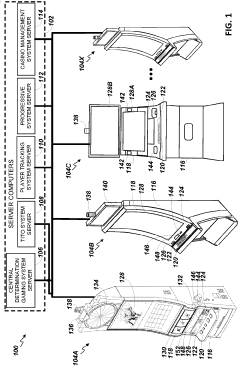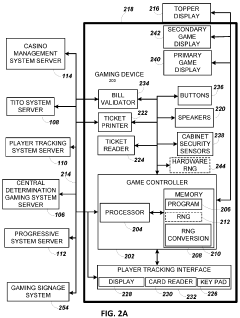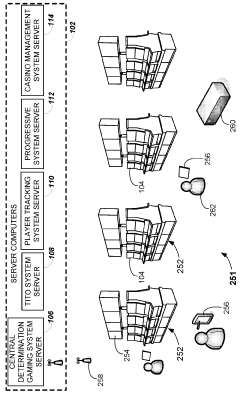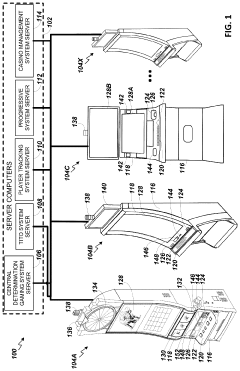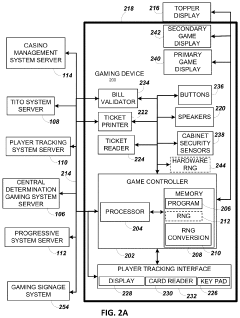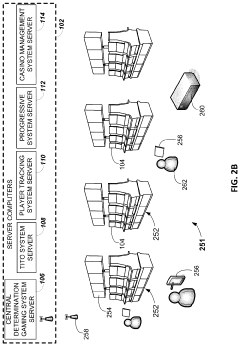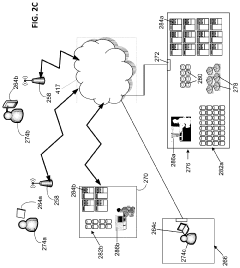QLED Displays: Unlocking Potential in Gaming
JUN 19, 20258 MIN READ
Generate Your Research Report Instantly with AI Agent
Patsnap Eureka helps you evaluate technical feasibility & market potential.
QLED Gaming Evolution
QLED display technology has undergone a remarkable evolution in the gaming industry, transforming the visual experience for players worldwide. The journey began with the introduction of Quantum Dot Light Emitting Diode (QLED) technology, which offered superior color reproduction and brightness compared to traditional LED displays. As gaming demands increased, QLED displays adapted to meet the needs of high-performance gaming.
The first generation of QLED gaming displays focused on enhancing color gamut and peak brightness. These improvements allowed for more vibrant and lifelike game worlds, particularly benefiting titles with rich, colorful environments. However, early QLED gaming monitors still struggled with response times and refresh rates, limiting their appeal to competitive gamers.
Subsequent iterations addressed these shortcomings, with manufacturers developing QLED panels capable of higher refresh rates and lower response times. This breakthrough allowed QLED technology to compete with established gaming display technologies like IPS and TN panels. The introduction of 144Hz and even 240Hz QLED gaming monitors marked a significant milestone, offering smooth motion and reduced input lag crucial for fast-paced gaming.
As QLED technology matured, it began to incorporate features specifically tailored for gaming. Variable refresh rate technologies like AMD FreeSync and NVIDIA G-Sync were integrated, eliminating screen tearing and stuttering. HDR capabilities were also enhanced, with QLED displays capable of achieving the high brightness and contrast ratios necessary for HDR gaming content.
The most recent developments in QLED gaming displays have focused on pushing the boundaries of resolution and screen size. 4K QLED gaming monitors have become more prevalent, offering incredibly detailed visuals for both competitive and immersive gaming experiences. Additionally, ultra-wide and super ultra-wide QLED monitors have gained popularity, providing expansive field of view and enhanced peripheral vision in games.
Looking towards the future, QLED gaming displays are poised to continue evolving. Emerging trends include the development of 8K QLED gaming monitors, further improvements in HDR performance, and the integration of AI-enhanced upscaling technologies to optimize gaming visuals. As game developers create more graphically demanding titles, QLED displays are expected to adapt, potentially incorporating advanced local dimming techniques and even faster response times to meet the ever-growing demands of the gaming community.
The first generation of QLED gaming displays focused on enhancing color gamut and peak brightness. These improvements allowed for more vibrant and lifelike game worlds, particularly benefiting titles with rich, colorful environments. However, early QLED gaming monitors still struggled with response times and refresh rates, limiting their appeal to competitive gamers.
Subsequent iterations addressed these shortcomings, with manufacturers developing QLED panels capable of higher refresh rates and lower response times. This breakthrough allowed QLED technology to compete with established gaming display technologies like IPS and TN panels. The introduction of 144Hz and even 240Hz QLED gaming monitors marked a significant milestone, offering smooth motion and reduced input lag crucial for fast-paced gaming.
As QLED technology matured, it began to incorporate features specifically tailored for gaming. Variable refresh rate technologies like AMD FreeSync and NVIDIA G-Sync were integrated, eliminating screen tearing and stuttering. HDR capabilities were also enhanced, with QLED displays capable of achieving the high brightness and contrast ratios necessary for HDR gaming content.
The most recent developments in QLED gaming displays have focused on pushing the boundaries of resolution and screen size. 4K QLED gaming monitors have become more prevalent, offering incredibly detailed visuals for both competitive and immersive gaming experiences. Additionally, ultra-wide and super ultra-wide QLED monitors have gained popularity, providing expansive field of view and enhanced peripheral vision in games.
Looking towards the future, QLED gaming displays are poised to continue evolving. Emerging trends include the development of 8K QLED gaming monitors, further improvements in HDR performance, and the integration of AI-enhanced upscaling technologies to optimize gaming visuals. As game developers create more graphically demanding titles, QLED displays are expected to adapt, potentially incorporating advanced local dimming techniques and even faster response times to meet the ever-growing demands of the gaming community.
Gaming Market Dynamics
The gaming market has experienced exponential growth in recent years, driven by technological advancements, increased accessibility, and shifting consumer preferences. This dynamic landscape presents a significant opportunity for QLED display technology to make substantial inroads and potentially revolutionize the gaming experience.
The global gaming market has shown remarkable resilience and expansion, with projections indicating continued growth in the coming years. Mobile gaming has emerged as a dominant force, accounting for a substantial portion of the market share. However, console and PC gaming segments remain robust, with high-end gaming experiences driving demand for cutting-edge display technologies.
Esports has become a major contributor to market growth, with professional gaming tournaments attracting massive audiences and substantial prize pools. This trend has led to increased demand for high-performance gaming equipment, including displays that can deliver superior visual quality and responsiveness.
The COVID-19 pandemic has further accelerated market growth, as lockdowns and social distancing measures led to increased gaming engagement across all demographics. This surge in gaming activity has created a more diverse player base, expanding beyond traditional core gamers to include casual players and older age groups.
Consumer expectations for gaming displays have evolved significantly, with players demanding higher refresh rates, lower input lag, and enhanced color accuracy. These requirements align well with the potential advantages of QLED technology, which offers superior color reproduction and brightness compared to traditional LED displays.
The integration of cloud gaming services has introduced new dynamics to the market, potentially reducing the importance of local hardware. However, this trend also emphasizes the need for high-quality displays to fully leverage the capabilities of cloud-based gaming platforms.
Virtual Reality (VR) and Augmented Reality (AR) gaming segments are showing promising growth, presenting new opportunities for display technologies that can meet the unique requirements of immersive gaming experiences. QLED displays could play a crucial role in enhancing the visual fidelity of VR and AR gaming setups.
As gaming becomes increasingly social and content-creation focused, there is a growing demand for displays that can deliver exceptional visual quality for both gaming and streaming purposes. This dual-use scenario presents a compelling case for QLED technology adoption in the gaming market.
The global gaming market has shown remarkable resilience and expansion, with projections indicating continued growth in the coming years. Mobile gaming has emerged as a dominant force, accounting for a substantial portion of the market share. However, console and PC gaming segments remain robust, with high-end gaming experiences driving demand for cutting-edge display technologies.
Esports has become a major contributor to market growth, with professional gaming tournaments attracting massive audiences and substantial prize pools. This trend has led to increased demand for high-performance gaming equipment, including displays that can deliver superior visual quality and responsiveness.
The COVID-19 pandemic has further accelerated market growth, as lockdowns and social distancing measures led to increased gaming engagement across all demographics. This surge in gaming activity has created a more diverse player base, expanding beyond traditional core gamers to include casual players and older age groups.
Consumer expectations for gaming displays have evolved significantly, with players demanding higher refresh rates, lower input lag, and enhanced color accuracy. These requirements align well with the potential advantages of QLED technology, which offers superior color reproduction and brightness compared to traditional LED displays.
The integration of cloud gaming services has introduced new dynamics to the market, potentially reducing the importance of local hardware. However, this trend also emphasizes the need for high-quality displays to fully leverage the capabilities of cloud-based gaming platforms.
Virtual Reality (VR) and Augmented Reality (AR) gaming segments are showing promising growth, presenting new opportunities for display technologies that can meet the unique requirements of immersive gaming experiences. QLED displays could play a crucial role in enhancing the visual fidelity of VR and AR gaming setups.
As gaming becomes increasingly social and content-creation focused, there is a growing demand for displays that can deliver exceptional visual quality for both gaming and streaming purposes. This dual-use scenario presents a compelling case for QLED technology adoption in the gaming market.
QLED Tech Challenges
QLED (Quantum Dot Light Emitting Diode) displays have shown tremendous potential in the gaming industry, but they still face several technical challenges that need to be addressed to fully unlock their capabilities. One of the primary hurdles is the optimization of quantum dot efficiency and stability. While QLED technology offers superior color gamut and brightness compared to traditional LED displays, maintaining consistent performance over extended periods remains a challenge.
The production of uniform quantum dot layers across large display areas is another significant technical obstacle. Achieving consistent quantum dot distribution and size is crucial for maintaining color accuracy and brightness uniformity across the entire screen. This becomes increasingly difficult as display sizes grow, particularly for gaming monitors and TVs that often feature large screens.
Heat management is a critical issue in QLED displays, especially for gaming applications that demand high refresh rates and brightness levels. Excessive heat can degrade quantum dot performance and lifespan, potentially leading to color shift and reduced brightness over time. Developing effective thermal management solutions without compromising the display's slim profile is a complex engineering challenge.
Another area of concern is the blue light emission from QLED displays. While the technology offers vibrant colors, the high-energy blue light used to excite quantum dots can potentially cause eye strain during extended gaming sessions. Balancing the need for vivid visuals with user comfort and health considerations requires innovative approaches to light management and filtering.
The manufacturing process for QLED displays also presents challenges, particularly in terms of cost-effectiveness and scalability. Current production methods for high-quality quantum dots are complex and expensive, which can limit the widespread adoption of QLED technology in the gaming market. Developing more efficient and economical manufacturing techniques is crucial for making QLED displays more accessible to a broader range of consumers.
Additionally, improving the response time of QLED displays is essential for gaming applications. While QLED technology offers advantages in color reproduction and brightness, it still lags behind OLED in terms of pixel response times. Enhancing the switching speed of quantum dots without compromising other performance aspects is a key area of research and development.
Lastly, the integration of QLED technology with other advanced display features, such as variable refresh rates and HDR, presents its own set of challenges. Ensuring seamless compatibility and optimal performance across various gaming platforms and content types requires sophisticated hardware and software solutions. As the gaming industry continues to push the boundaries of visual fidelity and responsiveness, QLED displays must evolve to meet these ever-increasing demands.
The production of uniform quantum dot layers across large display areas is another significant technical obstacle. Achieving consistent quantum dot distribution and size is crucial for maintaining color accuracy and brightness uniformity across the entire screen. This becomes increasingly difficult as display sizes grow, particularly for gaming monitors and TVs that often feature large screens.
Heat management is a critical issue in QLED displays, especially for gaming applications that demand high refresh rates and brightness levels. Excessive heat can degrade quantum dot performance and lifespan, potentially leading to color shift and reduced brightness over time. Developing effective thermal management solutions without compromising the display's slim profile is a complex engineering challenge.
Another area of concern is the blue light emission from QLED displays. While the technology offers vibrant colors, the high-energy blue light used to excite quantum dots can potentially cause eye strain during extended gaming sessions. Balancing the need for vivid visuals with user comfort and health considerations requires innovative approaches to light management and filtering.
The manufacturing process for QLED displays also presents challenges, particularly in terms of cost-effectiveness and scalability. Current production methods for high-quality quantum dots are complex and expensive, which can limit the widespread adoption of QLED technology in the gaming market. Developing more efficient and economical manufacturing techniques is crucial for making QLED displays more accessible to a broader range of consumers.
Additionally, improving the response time of QLED displays is essential for gaming applications. While QLED technology offers advantages in color reproduction and brightness, it still lags behind OLED in terms of pixel response times. Enhancing the switching speed of quantum dots without compromising other performance aspects is a key area of research and development.
Lastly, the integration of QLED technology with other advanced display features, such as variable refresh rates and HDR, presents its own set of challenges. Ensuring seamless compatibility and optimal performance across various gaming platforms and content types requires sophisticated hardware and software solutions. As the gaming industry continues to push the boundaries of visual fidelity and responsiveness, QLED displays must evolve to meet these ever-increasing demands.
Current QLED Solutions
01 Quantum dot light-emitting diode structure
QLED displays utilize a structure incorporating quantum dots as the light-emitting material. This structure typically includes layers such as a substrate, electrodes, quantum dot layer, and charge transport layers. The quantum dots are engineered to emit specific colors when electrically excited, providing high color purity and efficiency.- Quantum dot light-emitting diode structure: QLED displays utilize a structure incorporating quantum dots as the light-emitting material. This structure typically includes layers such as a substrate, electrodes, quantum dot layer, and charge transport layers. The quantum dots are engineered to emit specific colors when electrically excited, providing high color purity and efficiency.
- Color conversion and enhancement: QLED technology employs quantum dots for color conversion and enhancement. This involves using blue LEDs as a backlight source and quantum dots to convert some of the blue light into red and green, resulting in a wider color gamut and improved color accuracy compared to traditional LCD displays.
- Quantum dot synthesis and composition: The synthesis and composition of quantum dots play a crucial role in QLED display performance. Research focuses on developing quantum dots with high quantum yield, narrow emission spectra, and improved stability. Various materials and core-shell structures are explored to optimize the optical and electronic properties of quantum dots.
- Quantum dot deposition and patterning techniques: Advanced deposition and patterning techniques are essential for fabricating high-quality QLED displays. These methods include inkjet printing, photolithography, and transfer printing. The goal is to achieve precise control over quantum dot placement and uniformity, which directly impacts display resolution and performance.
- QLED display driving and control systems: Specialized driving and control systems are developed for QLED displays to optimize their performance. These systems manage factors such as current distribution, voltage control, and thermal management to ensure uniform brightness, color accuracy, and longevity of the display. Advanced algorithms and circuitry are employed to address the unique characteristics of quantum dot-based displays.
02 Color conversion layer using quantum dots
Some QLED display designs use quantum dots as a color conversion layer rather than direct light emitters. In this approach, blue LEDs are used as a backlight, and quantum dots convert the blue light to red and green, creating a full-color display. This method can improve color gamut and energy efficiency compared to traditional LCD displays.Expand Specific Solutions03 Quantum dot synthesis and composition
The performance of QLED displays heavily depends on the properties of the quantum dots used. Research focuses on developing new quantum dot compositions, improving synthesis methods, and enhancing stability. This includes exploring different core/shell structures, doping techniques, and surface treatments to optimize optical and electrical properties.Expand Specific Solutions04 Quantum dot patterning and deposition techniques
Efficient and precise deposition of quantum dots is crucial for QLED display manufacturing. Various techniques are being developed and improved, including inkjet printing, photolithography, and transfer printing. These methods aim to achieve high-resolution patterning, uniform deposition, and compatibility with large-scale production.Expand Specific Solutions05 QLED display driving and control systems
Advanced driving and control systems are essential for optimizing QLED display performance. This includes developing efficient backplane technologies, implementing sophisticated color management algorithms, and designing power management systems. These innovations aim to enhance image quality, reduce power consumption, and extend the lifespan of QLED displays.Expand Specific Solutions
QLED Industry Leaders
The QLED display market for gaming is in a growth phase, driven by increasing demand for high-quality visuals in gaming experiences. The market size is expanding rapidly, with major players like Samsung Electronics, Sony Interactive Entertainment, and BOE Technology Group competing for market share. Technologically, QLED displays are maturing, with companies like TCL China Star Optoelectronics and Sharp Corp. making significant advancements. The technology's adoption in gaming is accelerating, as evidenced by involvement from gaming industry leaders such as Aristocrat Technologies and Konami Digital Entertainment. This competitive landscape suggests a dynamic market with potential for further innovation and market expansion in the gaming sector.
BOE Technology Group Co., Ltd.
Technical Solution: BOE has developed advanced QLED display technology specifically tailored for gaming applications. Their solution incorporates quantum dot technology to enhance color gamut and brightness, while also implementing high refresh rates and low response times. BOE's gaming-focused QLED displays feature local dimming for improved contrast ratios and HDR performance. They have also integrated variable refresh rate technology to reduce screen tearing and stuttering during gameplay. Additionally, BOE has developed a special blue light reduction mode to minimize eye strain during extended gaming sessions.
Strengths: Wide color gamut, high brightness, low latency, and gaming-specific features. Weaknesses: Higher production costs compared to traditional LCD, potential for burn-in with static images.
TCL China Star Optoelectronics Technology Co., Ltd.
Technical Solution: TCL CSOT has developed QLED display technology optimized for gaming experiences. Their solution combines quantum dot technology with mini-LED backlighting to achieve high contrast ratios and precise local dimming. TCL CSOT's gaming QLED displays offer a wide color gamut covering over 90% of the DCI-P3 color space. They have implemented a rapid response time of 1ms MPRT (Moving Picture Response Time) and support for variable refresh rates up to 144Hz. TCL CSOT has also integrated gaming-specific features such as black frame insertion for reduced motion blur and a game mode that optimizes picture settings for different game genres.
Strengths: Competitive pricing, good balance of picture quality and gaming performance. Weaknesses: Less established brand in gaming displays, potentially lower peak brightness compared to some competitors.
QLED Gaming Patents
Automated pixel refresh mode for organic light-emitting diode displays used in continuous-use contexts
PatentPendingAU2023237066A1
Innovation
- Implementing a mode-switching system that transitions OLED displays from a graphical content mode to a pixel refresh mode and back, scheduled during minimal impact times, such as early morning hours when usage is low, to perform pixel refresh routines regularly and prevent burn-in while maximizing uptime.
Automated pixel refresh mode for organic light-emitting diode displays used in continuous-use contexts
PatentPendingUS20240112531A1
Innovation
- An electronic gaming machine is configured to switch between a mode displaying graphical content and a mode performing a pixel refresh routine, with scheduled transitions during minimal impact times, such as early morning hours, to prevent burn-in and prolong OLED display lifespan.
QLED vs OLED Gaming
QLED (Quantum Dot Light Emitting Diode) and OLED (Organic Light Emitting Diode) are two leading display technologies that have gained significant traction in the gaming industry. Both offer unique advantages and drawbacks, making the choice between them a crucial decision for gamers seeking the ultimate visual experience.
QLED displays utilize quantum dots to enhance color reproduction and brightness. These nano-sized semiconductor particles emit light when excited by electricity, resulting in vibrant and highly saturated colors. QLED panels typically offer higher peak brightness levels compared to OLED, which can be particularly beneficial in well-lit gaming environments or for HDR content.
On the other hand, OLED displays use organic compounds that emit light when an electric current is applied. This technology allows for individual pixel control, resulting in perfect blacks and infinite contrast ratios. OLED panels excel in producing deep, inky blacks and offer superior viewing angles, which can enhance immersion in dark scenes and provide consistent image quality from various viewing positions.
In terms of response time and input lag, both QLED and OLED displays have made significant improvements in recent years. OLED generally has the edge in pixel response times, with near-instantaneous pixel transitions that minimize motion blur and ghosting. However, high-end QLED displays have narrowed this gap considerably, offering competitive performance for fast-paced gaming.
Longevity and burn-in resistance are areas where QLED displays have an advantage. QLED panels are less susceptible to image retention and burn-in issues compared to OLED, which can be a concern for gamers who spend extended periods playing games with static elements on screen.
When it comes to gaming-specific features, both technologies support high refresh rates, variable refresh rate (VRR) technologies like FreeSync and G-Sync, and low input lag modes. The implementation of these features can vary between manufacturers and models, so it's essential to consider individual product specifications.
Cost is another factor to consider. QLED displays are generally more affordable than OLED panels of comparable size and specifications. This price difference can be significant, especially for larger screen sizes, making QLED an attractive option for budget-conscious gamers.
In conclusion, the choice between QLED and OLED for gaming largely depends on individual preferences and priorities. QLED offers advantages in brightness, color volume, and longevity, while OLED excels in contrast, black levels, and overall picture quality. As both technologies continue to evolve, gamers can expect further improvements and innovations that will enhance their gaming experiences.
QLED displays utilize quantum dots to enhance color reproduction and brightness. These nano-sized semiconductor particles emit light when excited by electricity, resulting in vibrant and highly saturated colors. QLED panels typically offer higher peak brightness levels compared to OLED, which can be particularly beneficial in well-lit gaming environments or for HDR content.
On the other hand, OLED displays use organic compounds that emit light when an electric current is applied. This technology allows for individual pixel control, resulting in perfect blacks and infinite contrast ratios. OLED panels excel in producing deep, inky blacks and offer superior viewing angles, which can enhance immersion in dark scenes and provide consistent image quality from various viewing positions.
In terms of response time and input lag, both QLED and OLED displays have made significant improvements in recent years. OLED generally has the edge in pixel response times, with near-instantaneous pixel transitions that minimize motion blur and ghosting. However, high-end QLED displays have narrowed this gap considerably, offering competitive performance for fast-paced gaming.
Longevity and burn-in resistance are areas where QLED displays have an advantage. QLED panels are less susceptible to image retention and burn-in issues compared to OLED, which can be a concern for gamers who spend extended periods playing games with static elements on screen.
When it comes to gaming-specific features, both technologies support high refresh rates, variable refresh rate (VRR) technologies like FreeSync and G-Sync, and low input lag modes. The implementation of these features can vary between manufacturers and models, so it's essential to consider individual product specifications.
Cost is another factor to consider. QLED displays are generally more affordable than OLED panels of comparable size and specifications. This price difference can be significant, especially for larger screen sizes, making QLED an attractive option for budget-conscious gamers.
In conclusion, the choice between QLED and OLED for gaming largely depends on individual preferences and priorities. QLED offers advantages in brightness, color volume, and longevity, while OLED excels in contrast, black levels, and overall picture quality. As both technologies continue to evolve, gamers can expect further improvements and innovations that will enhance their gaming experiences.
QLED Energy Efficiency
QLED displays have made significant strides in energy efficiency, positioning themselves as a competitive option in the gaming market. The quantum dot technology at the core of QLED displays allows for improved light emission and color reproduction while consuming less power compared to traditional LED displays.
One of the key factors contributing to QLED's energy efficiency is the use of quantum dots, which can emit light more efficiently than conventional phosphors. This results in less energy being wasted as heat, leading to lower power consumption overall. Additionally, the precise control over color output means that QLED displays can achieve higher brightness levels with less power input, further enhancing their energy efficiency.
The backlight system in QLED displays has also been optimized for energy conservation. Many QLED models utilize local dimming technology, which allows for selective dimming of specific areas of the screen. This not only improves contrast but also reduces power consumption by dimming or turning off LEDs in darker areas of the image.
Furthermore, QLED displays often incorporate advanced power management systems that adjust brightness and contrast based on ambient lighting conditions and content being displayed. This dynamic adjustment ensures that the display is not consuming more power than necessary, leading to improved energy efficiency during real-world usage scenarios.
In gaming applications, QLED's energy efficiency becomes particularly advantageous. The ability to maintain high brightness and vibrant colors without excessive power draw allows gamers to enjoy immersive experiences for extended periods without concerns about energy consumption or heat generation. This is especially relevant for competitive gaming, where long gaming sessions are common.
Manufacturers have also been focusing on developing more energy-efficient QLED panels specifically for gaming monitors. These panels often feature optimized refresh rates and response times while maintaining lower power consumption compared to their predecessors. The combination of high performance and energy efficiency makes QLED an attractive option for environmentally conscious gamers.
As the technology continues to evolve, we can expect further improvements in QLED energy efficiency. Research is ongoing to develop quantum dots with even higher light emission efficiency and to refine backlight systems for optimal power usage. These advancements will likely lead to QLED displays that offer even better energy performance while maintaining their superior color and brightness capabilities.
One of the key factors contributing to QLED's energy efficiency is the use of quantum dots, which can emit light more efficiently than conventional phosphors. This results in less energy being wasted as heat, leading to lower power consumption overall. Additionally, the precise control over color output means that QLED displays can achieve higher brightness levels with less power input, further enhancing their energy efficiency.
The backlight system in QLED displays has also been optimized for energy conservation. Many QLED models utilize local dimming technology, which allows for selective dimming of specific areas of the screen. This not only improves contrast but also reduces power consumption by dimming or turning off LEDs in darker areas of the image.
Furthermore, QLED displays often incorporate advanced power management systems that adjust brightness and contrast based on ambient lighting conditions and content being displayed. This dynamic adjustment ensures that the display is not consuming more power than necessary, leading to improved energy efficiency during real-world usage scenarios.
In gaming applications, QLED's energy efficiency becomes particularly advantageous. The ability to maintain high brightness and vibrant colors without excessive power draw allows gamers to enjoy immersive experiences for extended periods without concerns about energy consumption or heat generation. This is especially relevant for competitive gaming, where long gaming sessions are common.
Manufacturers have also been focusing on developing more energy-efficient QLED panels specifically for gaming monitors. These panels often feature optimized refresh rates and response times while maintaining lower power consumption compared to their predecessors. The combination of high performance and energy efficiency makes QLED an attractive option for environmentally conscious gamers.
As the technology continues to evolve, we can expect further improvements in QLED energy efficiency. Research is ongoing to develop quantum dots with even higher light emission efficiency and to refine backlight systems for optimal power usage. These advancements will likely lead to QLED displays that offer even better energy performance while maintaining their superior color and brightness capabilities.
Unlock deeper insights with Patsnap Eureka Quick Research — get a full tech report to explore trends and direct your research. Try now!
Generate Your Research Report Instantly with AI Agent
Supercharge your innovation with Patsnap Eureka AI Agent Platform!

